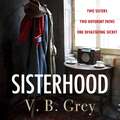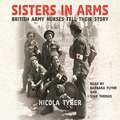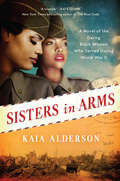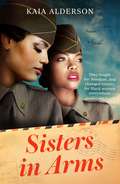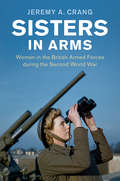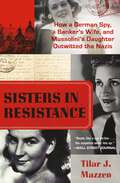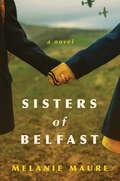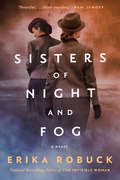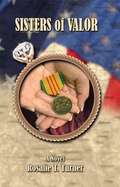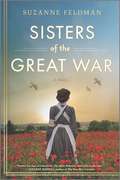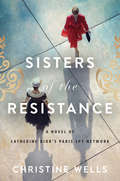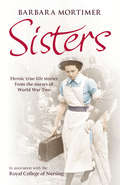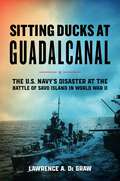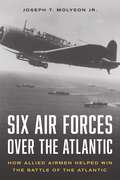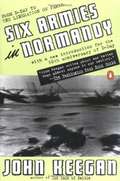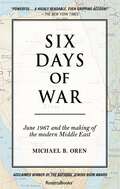- Table View
- List View
Sisterhood
by V. B. Grey'A BEAUTIFULLY WRITTEN STORY OF SISTERS AND THEIR FAMILIES WHOSE LIVES ARE PROFOUNDLY CHANGED BY WAR. GREY IS NOT AFRAID TO SEARCH IN THE SHADOWS FOR THE TRUTH. A TERRIFIC AND THOUGHT PROVOKING READ' ELIZABETH BUCHANIdentical twin sisters Freya and Shona take very different paths, leading to long-buried family secrets that reverberate through the generations in this thrilling novel of psychological suspense by the author of Tell Me How It Ends. There are some choices you can't come back from.It is 1944 in war-battered London. Freya and Shona are identical twins, close despite their different characters. Freya is a newly qualified doctor treating the injured in an East End hospital, while Shona has been recruited by the SOE. The sisters are so physically alike that they can fool people into thinking that one is the other. It's a game they've played since childhood. But when Shona persuades her twin to swap roles to meet her Polish lover, he is angered at being tricked. Then Shona proposes a far more dangerous swapping of roles. At first Freya refuses but finally she agrees, with consequences that threaten not only the happiness but the lives of both sisters. Forty-five years later in November 1989 Freya, now aged 69, is watching television with her daughter Kirsty. Freya is gripped as she witnesses crowds of Berliners attempting to knock down their hated Wall. This sight stirs memories of her own and her sister's war, especially the tragedy of the Warsaw Uprising - memories that she has never shared with anyone. Even if she wanted to reveal them now, she can't. She's suffering from a brain tumour and is unable to speak although her reason is unimpaired. And this is what she's thinking: if they succeed in knocking down the Wall, what secrets will come tumbling through? If her own were revealed, it would be devastating for all those close to her, especially her daughter, Kirsty.(P)2021 Quercus Editions Ltd
Sisters In Arms: British Army Nurses Tell Their Story
by Nicola TyrerThe remarkable true story of the Queen Alexandra frontline nurses in the Second World War.The amazing experiences of the Queen Alexandra nurses in the Second World War form one of the greatest adventure stories of modern times, and - incredibly - remain largely untold. Thousands of middle-class girls, barely out of school, were plucked from sheltered backgrounds, subjected to training regimes unimaginably tough by today's standards, and sent forth to share the harsh conditions of the fighting services. They had to deal with the most appalling suffering, yet most found reserves of inner strength that carried them through episodes of unrelieved horror.Over 200 nurses died, torpedoed in hospital ships, bombed in field hospitals or murdered in Japanese prison camps. Dozens won medals for gallantry. From the beaches of Dunkirk, to Singapore and D-Day, they saw it all. Whether tending burned pilots from the Battle of Britain or improvising medical treatment in Japanese death camps, their dedication was second to none. This is their story.
Sisters In Arms: British Army Nurses Tell Their Story
by Nicola TyrerThe remarkable true story of the Queen Alexandra frontline nurses in the Second World War.The amazing experiences of the Queen Alexandra nurses in the Second World War form one of the greatest adventure stories of modern times, and - incredibly - remain largely untold. Thousands of middle-class girls, barely out of school, were plucked from sheltered backgrounds, subjected to training regimes unimaginably tough by today's standards, and sent forth to share the harsh conditions of the fighting services. They had to deal with the most appalling suffering, yet most found reserves of inner strength that carried them through episodes of unrelieved horror.Over 200 nurses died, torpedoed in hospital ships, bombed in field hospitals or murdered in Japanese prison camps. Dozens won medals for gallantry. From the beaches of Dunkirk, to Singapore and D-Day, they saw it all. Whether tending burned pilots from the Battle of Britain or improvising medical treatment in Japanese death camps, their dedication was second to none. This is their story.
Sisters In Arms: British Army Nurses Tell Their Story
by Nicola TyrerThe amazing experiences of the Queen Alexandra nurses in the Second World War form one of the greatest adventure stories of modern times, and - incredibly - remain largely untold. Thousands of middle-class girls, barely out of school, were plucked from sheltered backgrounds, subjected to training regimes unimaginably tough by today's standards, and sent forth to share the harsh conditions of the fighting services. They had to deal with the most appalling suffering, yet most found reserves of inner strength that carried them through episodes of unrelieved horror.Over 200 nurses died, torpedoed in hospital ships, bombed in field hospitals or murdered in Japanese prison camps. Dozens won medals for gallantry. From the beaches of Dunkirk, to Singapore and D-Day, they saw it all. Whether tending burned pilots from the Battle of Britain or improvising medical treatment in Japanese death camps, their dedication was second to none. This is their story.Read by Barbara Flynn and Sian Thomas(p) 2008 Orion Publishing Group
Sisters Under the Rising Sun: A Novel
by Heather MorrisFrom the New York Times bestselling author of the multi-million copy bestseller The Tattooist of Auschwitz comes a story of sisterhood and survival, inspired by a true story.A phenomenal novel of resilience and survival from bestselling author of The Tattooist of Auschwitz, Heather Morris.In the midst of World War II, an English musician, Norah Chambers, places her eight-year-old daughter Sally on a ship leaving Singapore, desperate to keep her safe from the Japanese army as they move down through the Pacific. Norah remains to care for her husband and elderly parents, knowing she may never see her child again.Sister Nesta James, a Welsh Australian nurse, has enlisted to tend to Allied troops. But as Singapore falls to the Japanese she joins the terrified cargo of people, including the heartbroken Norah, crammed aboard the Vyner Brooke merchant ship. Only two days later, they are bombarded from the air off the coast of Indonesia, and in a matter of hours, the Vyner Brooke lies broken on the seabed.After surviving a brutal 24 hours in the sea, Nesta and Norah reach the beaches of a remote island, only to be captured by the Japanese and held in one of their notorious POW camps. The camps are places of starvation and brutality, where disease runs rampant. Sisters in arms, Norah and Nesta fight side by side every day, helping whoever they can, and discovering in themselves and each other extraordinary reserves of courage, resourcefulness and determination.Sisters under the Rising Sun is a story of women in war: a novel of sisterhood, bravery and friendship in the darkest of circumstances, from the multimillion-copy bestselling author of The Tattooist of Auschwitz, Cilka's Journey and Three Sisters.
Sisters in Arms: A Novel of the Daring Black Women Who Served During World War II
by Kaia Alderson“Sisters in Arms is heartwarming but fierce, a novel brimming with camaraderie and fire, starring women you’d love to make your friends. Prickly, musical Grace and bubbly, privileged Eliza may not make the most natural allies, but it’s fight or die when they’re thrown together in the Army’s first class of female officers—and the first Black women allowed to serve their country in World War II. . . . Kaia Alderson’s debut is a triumph!”— Kate Quinn, New York Times bestselling author of The Rose Code. <P><P> Kaia Alderson’s debut historical fiction novel reveals the untold, true story of the Six Triple Eight, the only all-Black battalion of the Women’s Army Corps, who made the dangerous voyage to Europe to ensure American servicemen received word from their loved ones during World War II. Grace Steele and Eliza Jones may be from completely different backgrounds, but when it comes to the army, specifically the Women’s Army Auxiliary Corps (WAAC), they are both starting from the same level. Not only will they be among the first class of female officers the army has even seen, they are also the first Black women allowed to serve. As these courageous women help to form the 6888th Central Postal Directory Battalion, they are dealing with more than just army bureaucracy—everyone is determined to see this experiment fail. For two northern women, learning to navigate their way through the segregated army may be tougher than boot camp. Grace and Eliza know that there is no room for error; they must be more perfect than everyone else. When they finally make it overseas, to England and then France, Grace and Eliza will at last be able to do their parts for the country they love, whatever the risk to themselves. <P><P> Based on the true story of the 6888th Postal Battalion (the Six Triple Eight), Sisters in Arms explores the untold story of what life was like for the only all-Black, female U.S. battalion to be deployed overseas during World War II.
Sisters in Arms: A gripping novel of the courageous Black women who made history in World War Two - inspired by true events
by Kaia AldersonA gripping and thrilling novel of the courageous Black women who made history in World War Two.Inspired by true events, and perfect for fans of Kate Quinn's The Alice Network and Hidden Figures.'Poignant and powerful; an untold story that you simply must read' NATASHA LESTERBased on the true story of the 6888th Postal Battalion (the Six Triple Eight), Sisters in Arms explores the untold story of what life was like for the only all-Black, female US battalion to be deployed overseas during World War Two.'Heartwarming but fierce, a novel brimming with camaraderie and fire, starring women you'd love to make your friends' KATE QUINN'A beautifully written love song to the brave, oft forgotten Black women who courageously stepped up to serve their country' FARRAH ROCHON'The story of these brave female soldiers will have you rooting for them with the turn of every page and brimming with pride. A triumph!' KWANA JACKSONThey were fighting for freedom everywhere. But the first battle they had to win was at home.Grace Steele and Eliza Jones make history when they join the Women's Army Auxiliary Corps, and form the 6888th Central Postal Directory Battalion. Not only are they among the first class of female officers the army has ever seen, they are also the first Black women allowed to serve. Everyone is determined to see this experiment fail and learning to navigate their way through the segregated army is tougher than boot camp. Grace and Eliza may be from completely different backgrounds but they both recognise that to succeed they must be more perfect than everyone else: there is no room for error. They know that what lies overseas in England and France could cause them great personal cost, but nothing is going to stop these courageous women from playing their parts for the country they love.'Well written, good characters that I loved and emotions that were up and down constantly. I didn't want it to end' 5* reader review
Sisters in Arms: British & American Women Pilots During World War II
by Helena Page SchraderDuring World War II, a few, carefully selected women in the US and the UK were briefly given the unprecedented opportunity to fly military aircraft. Yet the story of these pioneer women pilots is made even more intriguing by the fact that, despite many notable similarities in the utilisation and organisation of the women in their respective countries, they experienced radically different fates. Throughout the war, the contribution of the women of the British ATA to the war effort was recognized and praised both from official quarters and in the press. By contrast, the American WASPs were first glamorized and made into Hollywood stars - and then subjected to a slander campaign. What accounts for this dramatic difference in the treatment of women pilots doing essentially the same job? This book seeks to answer these questions. The women who participated in the ATA and WASP have been allowed to speak for themselves. The story these women have to tell is exciting and intriguing.
Sisters in Arms: Women in the British Armed Forces during the Second World War (Studies in the Social and Cultural History of Modern Warfare)
by Jeremy A. CrangDuring the Second World War some 600,000 women were absorbed into the Women's Auxiliary Air Force, the Auxiliary Territorial Service, and the Women's Royal Naval Service. These women performed important military functions for the armed forces, both at home and overseas, and the jobs they undertook ranged from cooking, typing and telephony to stripping down torpedoes, overhauling aircraft engines, and operating the fire control instruments in anti-aircraft gun batteries. In this wide-ranging study, which draws on a multitude of sources and combines organisational history with the personal experiences of servicewomen, Jeremy Crang traces the wartime history of the WAAF, ATS and WRNS and the integration of women into the British armed forces. Servicewomen came to play such an integral wartime role that the military authorities established permanent regular post-war women's services and, in so doing, opened up for the first time a military career for women.
Sisters in Captivity: Sister Betty Jeffrey OAM and the courageous story of Australian Army nurses in Sumatra, 1942–1945
by Colin BurgessThe incredible account of Sister Betty Jeffrey OAM and the Australian war nurses who survived the bombing of evacuation ship SS Vyner Brooke in February 1942, and subsequently spent three years in Japanese prison camps in Sumatra. During those perilous years surviving in squalid conditions, Sister Jeffrey kept a secret diary of day-to-day events which, after the war, was turned into a hugely successful book and radio serial: White Coolies. She would often write of the powerful sisterhood that evolved as the prisoners of war took strength from each other, even forming a vocal orchestra. White Coolies was a major inspiration for the 1997 film Paradise Road.Sisters in Captivity builds on those diaries to not only re-live the years the nurses spent as POWs but also recounts the early life and influences that encouraged Betty Jeffrey into the field of nursing as a lifelong endeavour. A tireless advocate for returned nurses, she co-founded the Australian Nurses Memorial Centre with sole survivor of the Banka Island Massacre, fellow POW, and her longtime friend Vivian Bullwinkel. Featuring 32 pages of photos including personal mementos of Betty Jeffrey, courtesy of her family, and her drawings from the prison camps, this is a powerful account of women&’s resilience amidst the devastating brutality of war.
Sisters in Resistance: How a German Spy, a Banker's Wife, and Mussolini's Daughter Outwitted the Nazis
by Tilar J. MazzeoIn a tale as twisted as any spy thriller, discover how three women delivered critical evidence of Axis war crimes to Allied forces during World War II: &“A tantalizingly novelistic history lesson" (Kirkus). In 1944, news of secret diaries kept by Italy's Foreign Minister, Galeazzo Ciano, had permeated public consciousness. What wasn't reported, however, was how three women—a Fascist's daughter, a German spy, and an American banker&’s wife—risked their lives to ensure the diaries would reach the Allies, who would later use them as evidence against the Nazis at Nuremberg. In 1944, Benito Mussolini's daughter, Edda, gave Hitler and her father an ultimatum: release her husband, Galeazzo Ciano, from prison, or risk her leaking her husband's journals to the press. To avoid the peril of exposing Nazi lies, Hitler and Mussolini hunted for the diaries for months, determined to destroy them. Hilde Beetz, a German spy, was deployed to seduce Ciano to learn the diaries' location and take them from Edda. As the seducer became the seduced, Hilde converted as a double agent, joining forces with Edda to save Ciano from execution. When this failed, Edda fled to Switzerland with Hilde&’s daring assistance to keep Ciano's final wish: to see the diaries published for use by the Allies. When American spymaster Allen Dulles learned of Edda's escape, he sent in Frances De Chollet, an &“accidental&” spy, telling her to find Edda, gain her trust, and, crucially, hand the diaries over to the Americans. Together, they succeeded in preserving one of the most important documents of WWII. Drawing from in‑depth research and first-person interviews with people who witnessed these events, Mazzeo gives readers a riveting look into this little‑known moment in history and shows how, without Edda, Hilde, and Frances's involvement, certain convictions at Nuremberg would never have been possible.Includes a Reading Group Guide.
Sisters in the Resistance: How Women Fought to Free France, 1940-1945
by Margaret Collins WeitzSisters in the Resistance renders homage to the courageous women of the French Resistance. It is high time for their contributions to be fully acknowledged, and fortunate indeed that they have found such a sympathetic, scholarly, and lucid chronicler in Margaret Collins Weitz.
Sisters of Belfast: A Novel
by Melanie MaureIn the spirit of Heather Morris, Kate Quinn, and Pam Jenoff, an enthralling and deeply moving story that begins during World War II, about orphaned twin sisters in Ireland whose lives diverge for decades, until fate—and faith—reunite them in the twilight of their lives.Orphaned during the Second World War, Aelish and Isabel McGuire—known as the twins of Belfast—are given over to the austere care of the Sisters of Bethlehem. Though they are each all the other has, the girls are propelled in opposite directions as they grow up. Rebellious Isabel turns her back on the church and Ireland, traveling to Newfoundland where she pursues a perilous yet independent life. Devout Aelish chooses to remain in Northern Ireland and takes the veil, burying painful truths beneath years of silence. For decades the two are separated, each unaware of the other’s life. But after years of isolation Aelish is unexpectedly summoned to Newfoundland, where she and her estranged sister begin to bridge the chasm between them.Reunion brings to light the painful secrets and seismic deceptions that have kept these sisters apart, leaving the McGuire twins to begin reconstructing their understanding about themselves as women and as family–what they know of love, hope, and above all, forgiveness.A story of faith—in religion, in the world, and in one another—Sisters of Belfast is a heartbreaking, tragic, and deeply moving novel about survival and the enduring power of sisterhood.
Sisters of Night and Fog: A WWII Novel
by Erika RobuckNamed a Most Anticipated Book of 2022 by Buzzfeed · Bookbub · BookTrib · and more!Two women, two countries. Nothing in common but a call to fight.A heart-stopping new novel based on the extraordinary true stories of an American socialite and a British secret agent whose stunning acts of courage collide in the darkest hours of World War II. 1940. In a world newly burning with war, and in spite of her American family&’s wishes, Virginia d&’Albert-Lake decides to stay in occupied France with her French husband. She&’s sure that if they keep their heads down, they&’ll survive. But is surviving enough? Nineteen-year-old Violette Szabo has seen the Nazis&’ evil up close and is desperate to fight them. But when she meets the man who&’ll change her life only for tragedy to strike, Violette&’s adrift. Until she enters the radar of Britain&’s secret war organization—the Special Operations Executive—and a new fire is lit in her as she decides just how much she&’s willing to risk to enlist. As Virginia and Violette navigate resistance, their clandestine deeds come to a staggering halt when they are brought together at Ravensbrück concentration camp. The decisions they make will change their lives, and the world, forever.
Sisters of Valor
by Connie Shelton Rosalie Turner Doann Houghton-AlicoA look into the life of four soldiers' wives.
Sisters of the Great War: A Novel
by Suzanne FeldmanInspired by real women, this powerful novel tells the story of two unconventional American sisters who volunteer at the front during World War IAugust 1914. While Europe enters a brutal conflict unlike any waged before, the Duncan household in Baltimore, Maryland, is the setting for a different struggle. Ruth and Elise Duncan long to escape the roles that society, and their controlling father, demand they play. Together, the sisters volunteer for the war effort—Ruth as a nurse, Elise as a driver.Stationed at a makeshift hospital in Ypres, Belgium, Ruth soon confronts war’s harshest lesson: not everyone can be saved. Rising above the appalling conditions, she seizes an opportunity to realize her dream to practice medicine as a doctor. Elise, an accomplished mechanic, finds purpose and an unexpected kinship within the all-female Ambulance Corps. Through bombings, heartache and loss, Ruth and Elise cherish an independence rarely granted to women, unaware that their greatest challenges are still to come.Illuminating the critical role women played in the Great War, this is a remarkable story of resilience, sacrifice and the bonds that can never be vanquished.
Sisters of the Resistance: A Novel of Catherine Dior's Paris Spy Network
by Christine WellsOne of PopSugar's Best Books of June!Two sisters join the Paris Resistance in this page-turning new novel inspired by the real-life bravery of Catherine Dior, sister of the fashion designer and a heroine of World War II France—perfect for fans of Kate Quinn and Jennifer Chiaverini."As dazzling as a Dior gown! With a gorgeous blend of fashion, heartbreak, heroism, and love this book will transport you to France...” —Natasha Lester, New York Times bestselling author of The Paris SecretParis, 1944: The war is nearly over, but for members of the Resistance in occupied France, it is more dangerous than ever before. Twenty-five-year-old Gabby Foucher loathes the Nazis, though as the concierge of 10 rue Royale, she does her best to avoid conflict—unlike her bolder sister Yvette, who finds trouble at every turn. Then they are both recruited into the Resistance by Catherine Dior and swept into a treacherous world of spies, fugitives, and intrigue. While Gabby risks everything for the man she is hiding from the Nazis, Yvette must decide whether to trust an enigmatic diplomat who seems to have guessed her secret. As the threat of betrayal draws ever-closer, one slip could mean the deaths of many, and both sisters must make choices they might regret. Paris, 1947: Yvette returns from New York to reunite with Gabby and begin life anew as a mannequin for Dior, who is revolutionizing fashion with the New Look. But first she must discover the truth behind Catherine’s terrible fate, while Gabby finds that there are many kinds of courage, and that love is always worth fighting for.
Sisters: Heroic true-life stories from the nurses of World War Two
by Barbara MortimerOn 3 September 1939, the Prime Minister declared that Britain was at war with Nazi Germany.Thousands of young women, many of them barely out of school, were sent headlong into gruelling training regimes that would see them become wartime nurses. Sisters features over 150 previously unpublished stories from the archives of the Royal College of Nursing. The vivid, poignant and riveting stories capture these nurses' incredible bravery and touching friendships.
Sisu, “Even Through a Stone Wall”: The Autobiography of Oskari Tokoi
by Oskari TokoiOriginally published in 1957, Sisu, “Even Through a Stone Wall” is the English-language edition of the memoirs of the Social Democratic premier of Finland of 1917, Oskari Tokoi. Included are his account of events in Helsinki and Russo-Finnish relations during 1917, the Finnish civil war, and the little-known story of the Finnish Legion’s role in the Allied intervention in North Russia.“‘sisu’…something that ‘surpasses fearlessness and extraordinary endurance...a kind of inner fire or superhuman nerve force....courage, tenacity, stubborn determination, energy and a will and an ability to get things done.’“The record is now before us, and it constitutes, in my opinion, an inspiring revelation of Finnish sisu. It took real bravery for a young country lad of eighteen to emigrate to the New World in 1891 and to toil long hours in the eerie half-darkness of Wyoming and Colorado mines, disdainful of the large chunks of rock and ore hanging overhead which seemed to warn: “Beware! Someday we’ll fall and bury you!”—John I. Kolehmainen
Sites of Memory, Sites of Mourning
by Jay WinterJay Winter's powerful study of the "collective remembrance" of the Great War offers a major reassessment of one of the critical episodes in the cultural history of the twentieth century. Dr. Winter looks anew at the culture of commemoration and the ways in which communities endeavored to find collective solace after 1918. Sites of Memory, Sites of Mourning is a profound and moving book of great importance for the attempt to understand the course of European history during the first half of the twentieth century.
Sitt Marie Rose
by Etel AdnanA short novel by the Christian Lebanese Poet, Etel Adnan, depicting some aspects of the social, political, sectarian, national, and gender dimensions of the Lebanese civil war.
Sitting Ducks at Guadalcanal: The U.S. Navy's Disaster at the Battle of Savo Island in World War II
by Lawrence A. De GrawOn August 7, 1942, U.S. Marines waded ashore in the Solomons, defended by warships of the U.S. Navy. The amphibious landing was the first major American ground campaign of the Pacific War, intended to prevent the Japanese from establishing naval and air bases in the island chain and to establish Allied bases for future operations. Most famously—and most gruelingly—the invasion marked the beginning of the months-long Guadalcanal campaign. Caught off guard, the Japanese swiftly regrouped for a seaborne counterattack on the night of August 8–9. The result was one of the worst American naval defeats of the war after Pearl Harbor.In this meticulous minute-by-minute retelling of the First Battle of Savo Island, Lawrence De Graw covers the navy&’s role in the initial landings on Guadalcanal before setting the stage for the naval clash that would come the next night. On the eighth, the American commander, fearing Japanese attacks and cautious about fuel levels, withdrew his aircraft carriers and let his cruisers and destroyers—exhausted from two days of high alert and combat—operate with only half their crews on duty. The navy was unaware the Japanese had been training to fight at night. The American ships were sitting ducks when the Japanese fleet steamed through &“The Slot&” between Savo Island and Guadalcanal and into what became known as &“Ironbottom Sound.&” In little more than thirty minutes, the Japanese sent three U.S. (and one Australian) heavy cruisers to the bottom and damaged three other vessels. The American fleet withdrew from the area for the foreseeable future and limited shipments of men and materiel to the daytime, helping turn the battle of Guadalcanal into a long, hard slog.Sitting Ducks at Guadalcanal is naval history, featuring a colorful narrative that covers the big picture as well as stories of individual vessels and sailors as well as a careful analysis of the battle and just what went wrong for the U.S. Navy off the island of Guadalcanal.
Six Air Forces Over the Atlantic: How Allied Airmen Helped Win the Battle of the Atlantic
by Joseph T. Molyson Jr.The Battle of the Atlantic was the longest campaign of World War II, lasting the entirety of the war in Europe from September 1939 to May 1945. It was also one of the war&’s most complex campaigns, involving strategy, operations, tactics, logistics, politics, diplomacy, and alliances. During the war&’s first two years, the United States was drawn deeper into partnership with Great Britain, and closer toward conflict with Germany, in the waters of the North Atlantic. Franklin Roosevelt realized this theater&’s importance: &“I believe the outcome of this struggle is going to be decided in the Atlantic.&” And so American, British, and Canadian forces battled Germans at sea and in the air to protect the flow of first materiel and then men from the United States to the United Kingdom. The sea part has been well covered: how German U-boats and other warships hunted Allied convoys and how the Allies ultimately turned the tide. Not so much the air war. In Six Air Forces over the Atlantic, Joseph Molyson tells the story of the Battle of the Atlantic from the perspective of the air forces—and airmen—who waged it from the skies above the icy waters of the North Atlantic. He blends big-picture attention to strategy and tactics with dramatic episodes of air-to-air and air-to-sea combat, including the engagement in which a British light bomber captured a German U-boat near Iceland. He details the close eye Franklin Roosevelt kept on the campaign, the effect B-24 Liberator bombers had, and the rise of the Royal Air Force Coastal Command as a true U-boat-busting force. The result was victory in the Atlantic, as well as a significant contribution to victory in World War II.
Six Armies In Normandy: From D-day To The Liberation Of Paris
by John KeeganThe armies of six nations met on the battlefields of Normandy in what was to be the greatest Allied achievement of World War II. With dramatic, driving power, John Keegan describes the massed armies—American, Canadian, English, French, German, and Polish—at successive stages of the invasion. As he details the strategies of the military engagements, Keegan brilliantly shows how each of the armies reflected its own nation's values and traditions. In a new introduction written especially to commemorate the 50th anniversary of D-Day, he contemplates the ways the events at the battle of Normandy still reverberate today.
Six Days of War
by Michael OrenFor six tense days between June 5 and 10, 1967, war raged between Israel and its neighbors, Egypt, Jordan, and Syria. There are many contexts in which this story makes sense, but only Michael Oren, a widely published American-born Israel scholar and historian, has so far knitted the diverse strands into a cohesive fabric that remains vital and relevant today. With educated authority and authorial integrity, Oren manages to sketch out facts and motives with the same intrigue as battles and strategies. Escalating territorial and populist tensions in the Middle East only serve to make this title more relevant. Anyone who wants to have a grasp of Middle Eastern politics or political tensions involving Israel must read this title. Six Days of War was a New York Times Bestseller and Washington Post Best Book Award Winner in 2002 and has gone on to be an internationally acclaimed bestseller. The book has been widely recognized as the definitive telling of the Six Day War. ABOUT THE AUTHOR Michael B. Oren is an American-born Israel scholar and historian. Oren has published numerous articles, books, and essays on the history and diplomatic affairs of the Middle East, and was appointed as Israeli Ambassador to the United States in 2009. Ambassador Oren has written extensively for The Wall Street Journal, The New York Times, and The New Republic, where he was a contributing editor. His two most recent books, Six Days of War: June 1967 and the Making of the Modern Middle East and Power, Faith, and Fantasy: America in the Middle East, 1776 to the Present, were both New York Times bestsellers. They won the Los Angeles Times History Book of the Year prize, the Washington Post Best Book Award, a National Council of the Humanities Award, and the National Jewish Book Award. Raised in New Jersey, Ambassador Oren moved to Israel in the 1970s. He served as an officer in the Israel Defense Forces, in the paratroopers in the Lebanon War, a liaison with the U.S. Sixth Fleet during the Gulf War, and an IDF spokesman during the Second Lebanon War and the Gaza operation in January 2009. He acted as an Israeli Emissary to Jewish refuseniks in the Soviet Union, as an advisor to Israel's delegation to the United Nations, and as the government's director of Inter-Religious Affairs.
